The Gift of South Dakota
Subscriptions to South Dakota Magazine make great gifts!
Subscribe today — 1 year (6 issues) is just $29!
Making Dignity
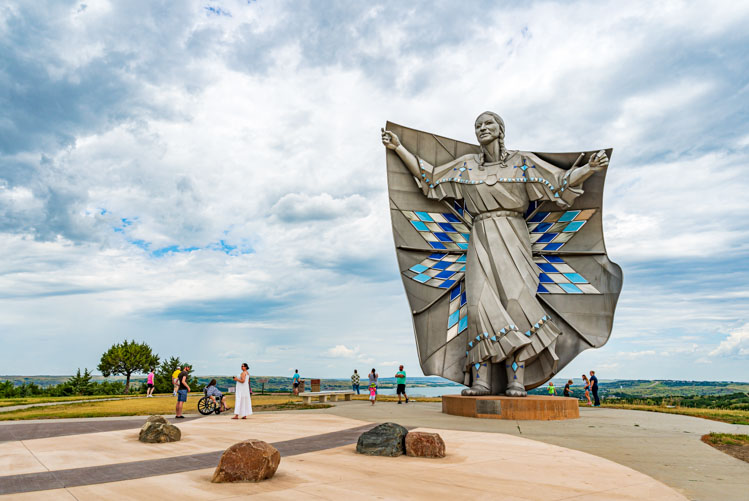 |
| Dignity, a 50-foot-tall stainless-steel tribute to indigenous culture, stands on a Missouri River bluff near Chamberlain. Photo by Chad Coppess |
Editor’s Note: This story appeared in the September/October 2016 issue of South Dakota Magazine in conjunction with the unveiling of Dale Lamphere’s grand sculpture Dignity of Earth and Sky along the Missouri River near Chamberlain.
For a year and a half, anticipation built across South Dakota and beyond about Dignity, Dale Lamphere’s 50-foot sculpture that overlooks the Missouri River from a dominant bluff. Millions see it every year as they drive past Chamberlain on Interstate 90.
The stainless-steel statue depicts a Native woman with a star quilt and is both traditional and boldly innovative in design. The traditional: the figure of the woman whose dress, leggings and moccasins are authentic to the mid-1800s, and whose face is an amalgamation of three Lakota women Lamphere used as models. The innovative: motion and changing light in the quilt, with more than 100 blue diamond shapes that move with the wind, fluttering “like an aspen leaf,” Lamphere explains.
Rapid City entrepreneurs Norm and Eunabel McKie put more than a million dollars into the project. They speak of Dignity as “alive” and, Norm says, carrying a burden of responsibility “to inspire all people to maximize their lives, and also to combat suicide,” sadly prevalent on nearby reservations.
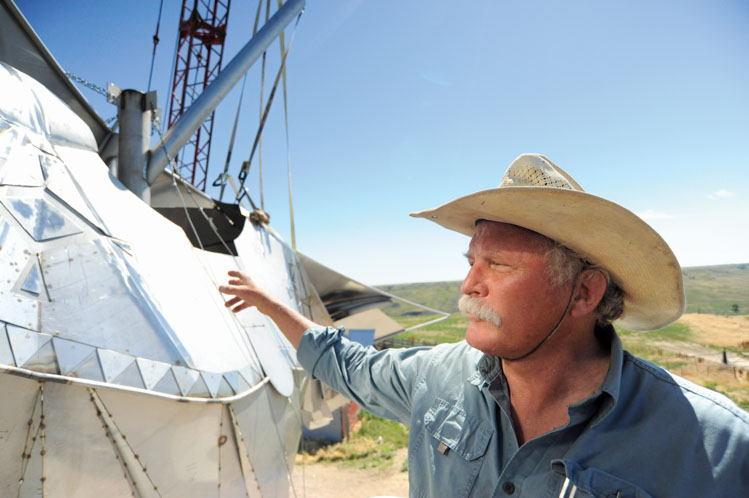 |
| South Dakota Artist Laureate Dale Lamphere's Dignity took shape during the summer of 2016. |
The McKies, owners of the McKie Ford/Lincoln car dealership in Rapid City, started talking in 2008 about giving something back to the state that’s been so good to them. Norm went to another Rapid City businessman, architect Pat Wyss, and over time they discussed possible projects. The day came, Norm remembers, when he realized “we could have this iconic sculpture, on the Missouri, in the heart of the state.” Wyss remained with the project from those conceptual discussions to placement at Chamberlain. He is landscape architect for the site, incorporating the hill’s natural slope toward the highway into the pedestal. The McKies and Wyss knew that in Lamphere, they were involving not only an artist of the highest caliber, but someone who shared their deep respect for South Dakota’s Native peoples.
Dignity also contributes to South Dakota tourism, an aspect of the project that excites supporters for reasons beyond revenue. The statue shines a light on the state’s center, too often overlooked by visitors, and makes a powerful statement about modern South Dakotans’ respect for the region’s original residents and cultures.
As South Dakotans know well, these art forms can take a long time to reach fruition. In this case, though, things moved swiftly after a lunch with Gov. Dennis Daugaard where the Dignity concept was explained in detail. “Let’s make this happen,” the governor said to staff who were present. State government quickly committed to having the statue stand on South Dakota-owned land, at the busy I-90 rest area just east of the river and south of Chamberlain, a place offering a sweeping view of the Missouri, bluffs and prairie.
Lamphere gave the project instant credibility. He’s been a professional sculptor for 50 years, with his main studio in the Black Hills foothills near Sturgis. Lamphere has more than 60 major commissions to his credit across the United States, from the Basilica of the National Shrine in Washington, D.C., to art at the Eisenhower Medical Center in southern California. Recent pieces have been installed in Dallas, Kansas City, Chicago and San Antonio. In his home state, Lamphere’s work is prominent at the state capitol building and public venues from Sioux Falls to Spearfish. Human subjects range from spiritual figures to strong and resilient residents of the Great Plains, many of them women.
Over his career, Lamphere has embraced big-scale sculpture (consider his 33-foot tall Sacred Heart of Jesus and Immaculate Heart of Mary, Queen of Peace works at Sioux City, Iowa). That quality draws inevitable comparisons to two historic South Dakota sculptors — Gutzon Borglum (Mount Rushmore) and Korczak Ziolkowski (Crazy Horse Memorial). Lamphere is quick to say he doesn’t consider himself in that league, a self-assessment over which others might squabble. In 2013, the day after he was presented the Governor’s Award in the Arts for his lifetime of distinctive creative achievement, Lamphere was greeted with a long ovation in the state legislature chambers — applause any high-ranking political leader would envy. In 2015 he was named South Dakota Artist Laureate.
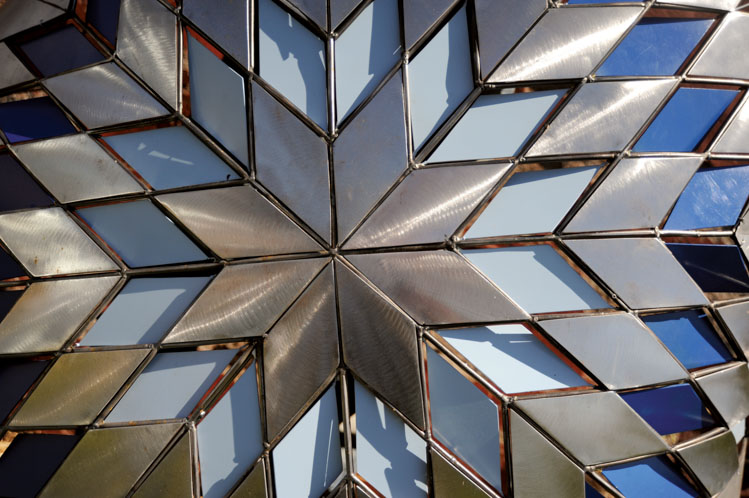 |
| More than 100 blue diamond shapes flutter with the wind "like an aspen leaf," Lamphere says. |
Lamphere began creating Dignity by first drawing the form, then sculpting a one eighth-scale model. He communicated regularly with the McKies, who, he notes, “let me pursue my highest vision.”
That vision — including incorporation of light, color and fluttering movement in the quilt — stemmed almost entirely from Lamphere’s imagination. “One of the advantages of living out here in relative isolation is how I have no idea what the rest of the world is doing,” the sculptor says. “So I play around in my imagination.”
The spot where the statue began taking form, where Lamphere multiplied precise measurements from the model and transferred them to steel, is truly isolated. It’s a worksite he’s used before, about 44 miles east of Rapid City on Highway 44, near the Cheyenne River. The location makes it easily accessible to Native people who live in rural southwestern South Dakota, and many stopped by to offer encouragement. “That means a lot,” Lamphere says.
For visitors, the site felt more like a ranch where workers would gather for branding rather than creating art. The Black Hills could be seen off in the distance, with miles of golden prairie in between. About 200 buffalo roam the ranch, and stacked hay bales and tractors decorated the homestead. Dozens of colorful and loud peacocks added flair.
Lamphere fit right in at the Spirited Winds Tatanka Ranch, with his western attire and manner. A shed served as the work base, crammed with tools and home to 30 or 40 kittens and an antler collection. But in front of that shed Dignity rose, surrounded by scaffolding for workers. “They have no idea,” Lamphere quipped, “how tiring it is for me to stand on the ground and yell instructions up to them.”
The ranch is in Tom Trople’s family. Trople has been Lamphere’s chief welder for three decades. Trople had a quip of his own. “These days Dale is pretty understanding that you can’t bend metal every direction — although sometimes he wants to.” Trople has worked on about 20 of Lamphere’s large-scale works, taller than 20 feet. “During that time, Dale’s become more like a brother than employer,” Trople says.
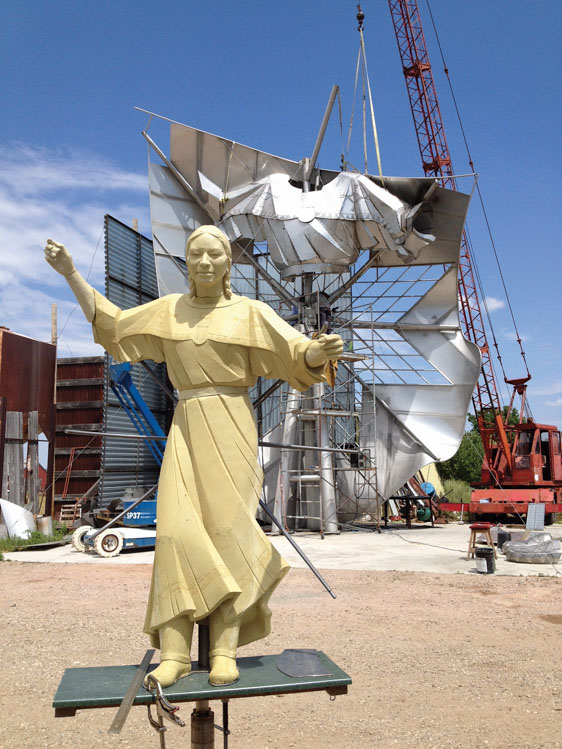 |
| Lamphere transferred measurements from a scale model to the stainless steel sculpture, which took shape on a ranch east of Rapid City. |
The involvement of highly regarded sculptors Jim Maher, Andy Roltgen and Grant Standard made the crew something of a dream team. Another important contribution came from Brook Loobey, an automotive paint expert who tackled the challenge of experimenting with colors for the quilt’s diamond-shaped pieces and implied beadwork. He and Lamphere studied color shades in the sun and imagined how those colors might change under different shades of natural light.
Workers dealt with windy conditions along the Cheyenne, which reminded them that the wind is a factor along the Missouri, too. Early on, Lamphere worked with Albertson Engineering of Rapid City to make certain Dignity withstands the most brutal prairie blasts South Dakota can produce. Openings through the quilt, where the diamond shapes hang, help with the wind load.
In considering Dignity’s full impact, more is at work than the intentions of the artist, benefactors and state of South Dakota. The venue — this exact bluff — witnessed complex history that is intertwined with the art’s statement. Lewis and Clark’s party camped directly across the river in 1804, and traditionally their story has been interpreted as a grand American adventure, with a Native woman playing a key role. But as historians and activists hammered home during the expedition’s bicentennial, those who followed the Lewis and Clark route brought diseases that devastated Native peoples of the Great Plains, Rocky Mountains and Pacific Northwest. Below the bluffs are a rail bed and trestle, reminders of the great political power railroads wielded in opening West River country to immigrants, greatly reducing reservation lands the Lakota people believed would be theirs forever. And the water below the bluff is called Lake Francis Case as often as the Missouri River, because dams completely altered South Dakota’s stretch of the river in the 1950s and ’60s and further stole reservation acreage.
Despite those and other historical indignities, the sculpture boldly proclaims that South Dakota’s Native cultures are alive, standing with dignity.


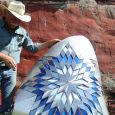
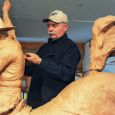

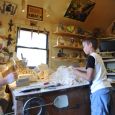




Comments
Elgin lL 60123-6226
Thank-you for your help t